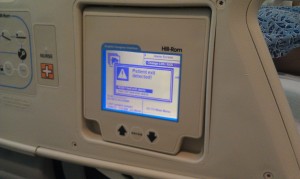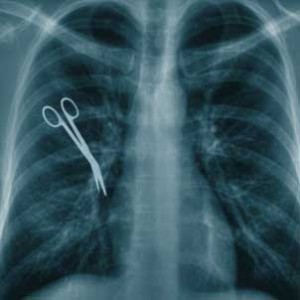The Ten Worst Hospital Design Features: A Family Member’s Perspective

An ICU Bed False Exit Alarm
I just spent the last 8 days in the hospital, at the bedside of a loved one. Although I squirmed the whole way through a tenuous ICU course and brief stop-over in a step-down unit, it was good for me to be reminded of what it feels like to be a patient – or at least the family member of one – in the hospital. The good news is that the staff were (by and large) excellent, and no major medical errors occurred. The bad news is that the experience was fairly horrific, mostly because of preventable design and process flaws. Having worked in a number of hospitals over the years, I recognized that these flaws were commonplace. So I’ve decided to tilt at this great hospital design “windmill” on my blog – with the hope that someone somewhere will make their hospital a friendlier place because of it.
Most of these design and process flaws have one thing in common: they prevent the patient from sleeping. In some circles, sleep deprivation is an organized form of torture reserved only for the most dangerous of terrorists. In other circles, it is hospital policy. And so, without further ado, here is my top 10 list of annoying hospital design flaws:
#1: False Alarms. Every piece of hospital equipment seems to be designed to beep for a complex list of reasons, many of which are either irrelevant or unhelpful. I snapped a photo of a particularly amusing (to me anyway) alarm (see above). This was a bed alert, signaling the “patient exit” of an intubated and sedated gentleman in the ICU. Not only was the location of the alert sign curious (if you could get close enough to the alert screen to read the text, you would surely already have noticed that the patient was AWOL) but it was triggered by mattress pressure changes that occurred when the patient was repositioned every 2 hours (as per ICU pressure ulcer prevention protocol).
The I.V. drip machines are probably one of the worst noise pollution offenders, beeping aggressively when an I.V. *might* need to be changed or when the patient coughs (this triggers the backflow pressure alarm, leading it to believe that a tube is blocked). Of course, I also thoroughly enjoyed the vitals monitor that beeped every time my loved one registered atrial fibrillation on the EKG strip – a rhythm he has been in and out of for years of his life.
#2: Intercom Systems. Apparently, some hospital intercom systems are wired into every patient room and permanently set at “full volume.” This way, every resting patient can enjoy the bleating cries for housekeeping, tray pickup, incoming nurse phone calls,physician pages, and transport requests for the entire floor full of individuals undergoing the sleep deprivation protocol.
#3: The Same Questions Ad Nauseum. Over-specialization is never more apparent than in the inpatient setting. There is a different team of doctors, nurses, PAs, and techs for every organ system – and sometimes one organ can have four teams of specialists. Take the heart for example – its electrical system has the cardiac electrophysiology team, the plumbing has the cardiothoracic surgery team, the cardiologists are the “minimally invasive” plumbers, and the intensivists take care of the heart in the ICU. Not only is a patient assigned all these individual micro-managing teams, but they work in groups – where they rotate vacations and on-call coverage with one another. This virtually insures that the sleep-deprived patient will be asked the same questions relentlessly by people who are seeing him for the very first time at 20 minute intervals throughout the day.
#4: Inopportune Intrusions. There are certain bodily functions that benefit from privacy. I was beginning to suspect that the plastic urinal was attached to the staff call bell after the fifth time that someone summarily entered my loved one’s room mid-stream. Enough said.
#5: Poorly Designed Tubing. Oxygen-carrying nasal cannulas seem to be designed to maintain a slight diagonal force on the face at all times. This results in the slow slide of the prongs from the nostrils towards the eye. Since the human eye is less efficient at absorbing oxygen than the lungs, one can guess what might happen to oxygen saturation levels to the average, sleep-deprived patient, and the resulting flurry of nursing disturbance that occurs at regular intervals throughout the night (and day). My loved one particularly enjoyed the flow of air pointed directly into his left eye as he attempted to rest.
#6: The Upside Down Call Bell. In an age of wireless technology, where almost every American has a cell phone and/or a flat screen television, it is odd that the light, TV, and nurse call bell control system must be tethered to a short cord positioned just outside of the patient’s reach. The controller is also designed so that the cord comes out of the box’s farthest point, causing it to remain upside down in the hands of anyone lucky enough to reach it from a chair or bed.
#7: Excessive Hospital Bands. In addition to multiple rotating IV access points, my loved one’s wrists and ankles were tagged with not one but four hospital band identifiers, including one neon yellow band sporting the ominous warning: “Fall risk.” If that little band is the only way that a staff member can ascertain a patient’s risk for falling down unassisted, then one is left to wonder about their powers of perception. In a moment of rare good humor, my loved one looked down at his assorted IV tubes and three plastic wrist bands and concluded, “I’m one stripe away from Admiral.”
#8: The Blank White Board. Sleep-deprivation-induced delirium can be rather disorienting. To help patients keep track of their core care team names, most hospital rooms have been outfitted with white boards. Ideally they are to be filled out each shift change so that the patient knows which activities are scheduled and the names of the staff that will be performing them. Filling out these boards is tiresome for staff members (not to mention that the dry erase markers are usually missing) and so they remain blank most of the time. This has an anxiety producing effect on patients, as the boards boldly proclaim that no nurse is taking care of them, and no activities are scheduled. I also noted that the size of the board lettering was a fraction smaller than a person with 20/20 vision could make out from the distance of the bed.
#9: The Slightly-Too-Tight Pulse Oximeter. Because being tethered to a bed with IV tubing, telemetry cords, and a nasal cannula is not quite irritating enough, hospital staff have devised a way to keep one unhappy finger in a constant, mild vice grip. This device monitors oxygenation status and helps to trigger alarms when nasal cannulas achieve their usual peri-ocular destination every 30 minutes or so.
#10: The Ticking And Creaking IV Drip. During the few rare moments of quiet, we did not enjoy any sort of blissful silence, but rather the incessant ticking of the I.V. drip machine. My loved one remarked that he felt as if he were trapped in an endless recording loop of the first 5 seconds of the TV show “Sixty Minutes.” And so if the alarms, tethering, interruptions, PA announcements, tubing, or white boards didn’t drive you mad, the auditory reinforcement of a ticking time bomb next to your head could bring you close to tears.
And so, because of all these nuisances (not to mention the ill-fitting hospital gowns, inedible food, and floors covered with various forms of “seepage” that penetrated patient socks on hallway ambulation attempts) we had one of the most unpleasant experiences in recent memory. All this, and no dissatisfaction with the surgical team or the primary procedure performed during the hospital stay. In the end, it’s the little things that can drive you crazy – or make you well.



 Seeking Shelter
Seeking Shelter Alright, I admit that the title of this post is a little dramatic. But it really does seem that most people I know socially have had a bad experience with the healthcare system lately. Take for example my friend whose 3- year-old went to the hospital for a common pediatric procedure – the little girl was overdosed on a medicine, aspirated, got pneumonia, went into respiratory distress (noticed first by her mom) and remained in the pediatric ICU for several days. The hospital staff swept the overdose under the rug, and outright denied it happened when faced with direct questioning. As outrageous as that all is, my friend chose not to pursue action against the hospital and staff for their error and behavior. She just “let it go” because no permanent harm had occurred.
Alright, I admit that the title of this post is a little dramatic. But it really does seem that most people I know socially have had a bad experience with the healthcare system lately. Take for example my friend whose 3- year-old went to the hospital for a common pediatric procedure – the little girl was overdosed on a medicine, aspirated, got pneumonia, went into respiratory distress (noticed first by her mom) and remained in the pediatric ICU for several days. The hospital staff swept the overdose under the rug, and outright denied it happened when faced with direct questioning. As outrageous as that all is, my friend chose not to pursue action against the hospital and staff for their error and behavior. She just “let it go” because no permanent harm had occurred.
 Every day I go to work and spend time with suffering people. They come to me for help and for comfort. They open up to me with problems that they would not tell anyone else. They put trust in me — even if I am not able to fix their problems. I serve as a source of healing, but I also am a source of hope.
Every day I go to work and spend time with suffering people. They come to me for help and for comfort. They open up to me with problems that they would not tell anyone else. They put trust in me — even if I am not able to fix their problems. I serve as a source of healing, but I also am a source of hope.








